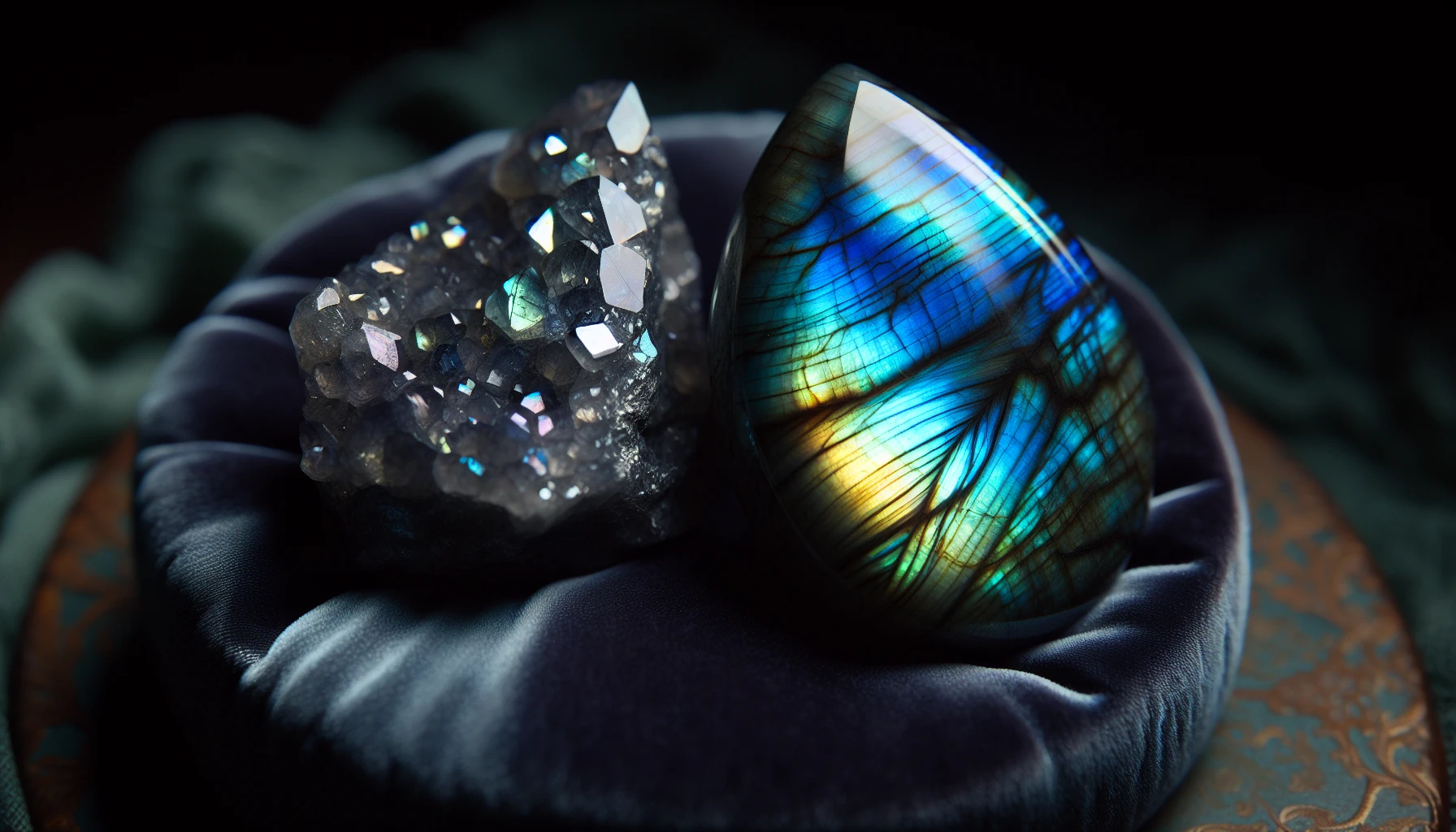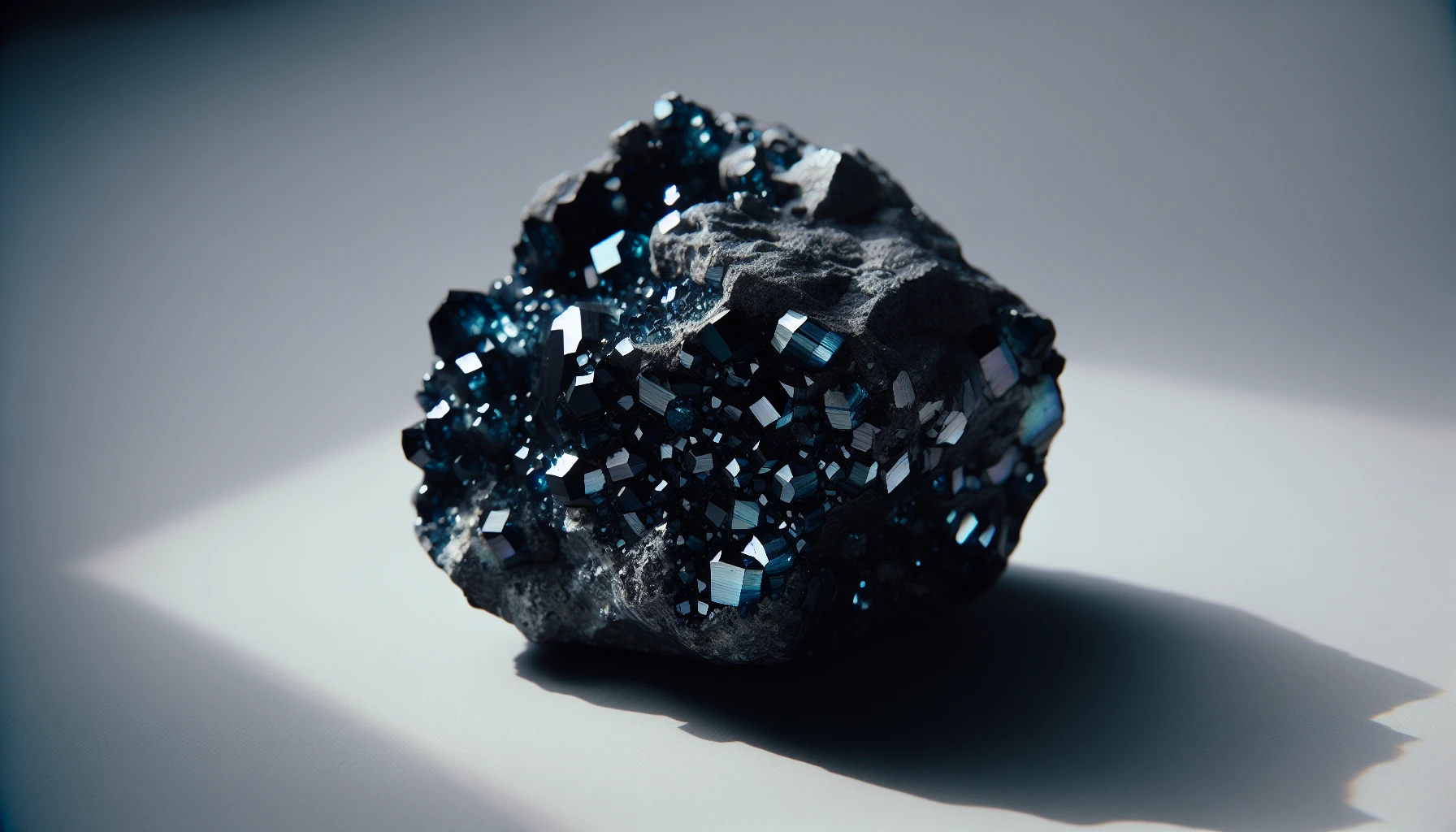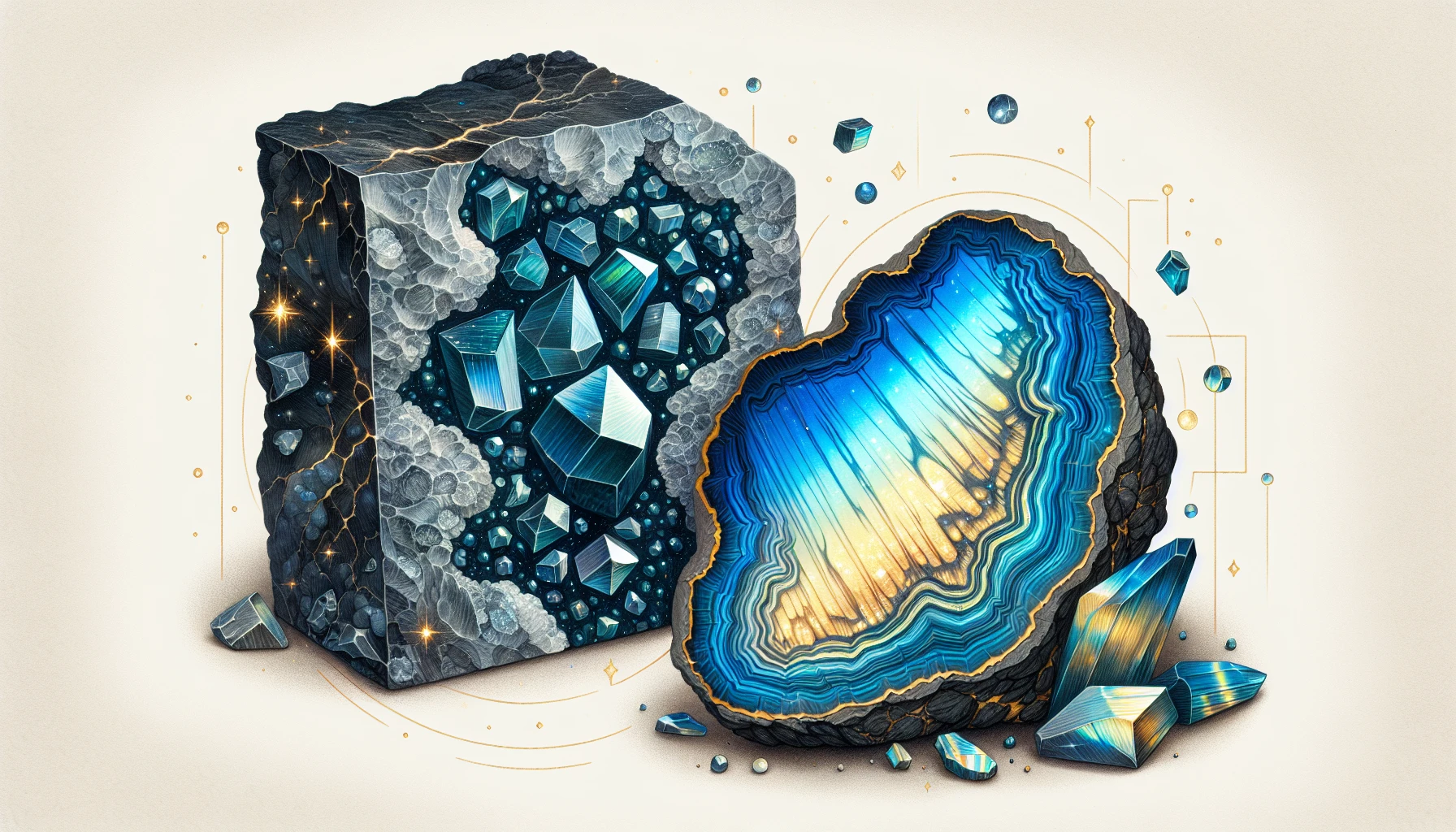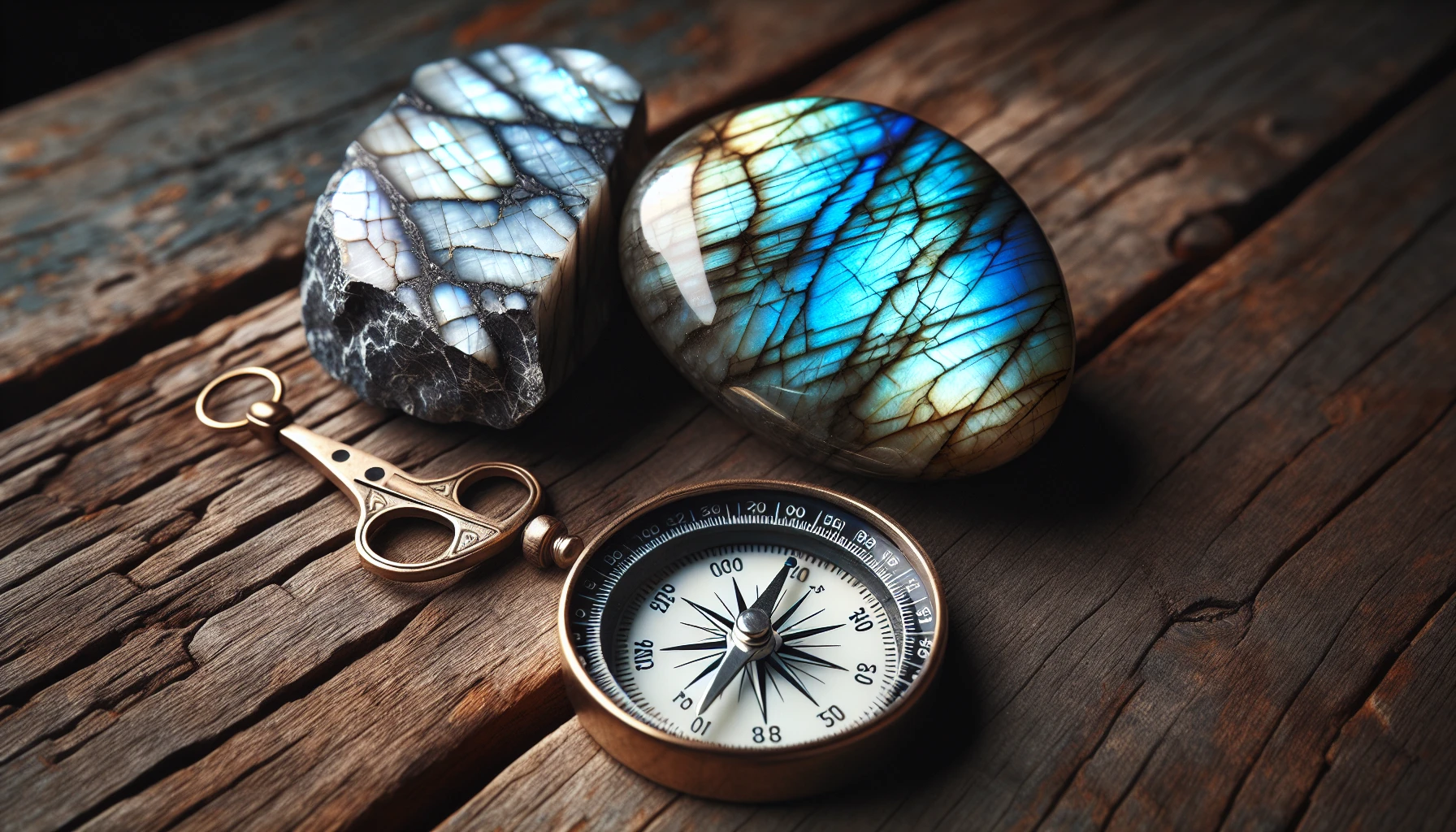Larvikite and Labradorite are unique gemstones with distinct characteristics. Larvikite, found only in Norway, is a dark igneous rock with blue and silver crystals. It has a dense structure due to slow cooling. Labradorite is known for its vibrant play of colors, or labradorescence, resulting from faster cooling. Both stones belong to the feldspar family, share similar hardness, and are non-magnetic. They are used in jewelry, construction, and spiritual practices. This article provides tips for distinguishing between larvikite vs labradorite.
Key Takeaways
- Unveil the mysteries of Larvikite and Labradorite, two unique stones with distinct properties originating from different parts of the world.
- Compare visual appeal, mineral composition and formation process to distinguish between larvikite and labradorite.
- Utilize tips on color & luster assessment, crystal structure examination & weight/density comparison for gemstone selection purposes.
Unveiling the Mysteries: Larvikite and Labradorite

Larvikite and labradorite, although visually similar, are two distinct stones with unique properties. Hailing from different parts of the world, each stone offers its own set of visual and metaphysical characteristics.
Larvikite, often referred to as the Norwegian Blue Pearl, is a dark igneous rock with blue and silver shimmering crystals found exclusively in Norway. This unique rock, which belongs to the family of igneous rocks, is sometimes also called blue granite due to its appearance. Labradorite, on the other hand, is a gemstone known for its transformative properties and striking labradorescence, found in various locations worldwide.
Unveil the mysteries of these captivating stones, including black moonstone, and learn how to distinguish between them.
Larvikite: The Norwegian Blue Pearl

Larvikite is a black igneous rock composed of feldspar, with large masses rich in rich mafic minerals. This captivating stone is primarily sourced from Larvik, Norway, where it gets its name. Larvikite is often referred to as labradorite alike or black labradorite due to its similarities with labradorite, another member of the feldspar family. The stone’s unique appearance, characterized by small silver-blueish shimmering crystals, creates a striking iridescence and schiller effect. This effect, reminiscent of the northern lights, contributes to larvikite’s stunning visual appeal.
Larvikite’s formation process is believed to have taken place approximately 298 million years ago, at an estimated depth of 18 miles below the earth’s crust. This slow cooling process allowed the minerals within the stone to crystallize and grow, resulting in the dense and eye-catching crystal structure we see today. Its connection to Norway and the beauty of its iridescent flashes have earned larvikite the nickname “Norwegian Blue Pearl.”
Labradorite: The Gemstone of Transformation
Labradorite, a feldspar mineral, has gained recognition for its unique play of colors called labradorescence. This optical phenomenon occurs when light interacts with the arrangement of minerals on the surface of the stone, creating a captivating display of colors that range from blue and green to gold and orange. A variety of this gemstone, called black labradorite, can be found in various locations worldwide, such as Canada, Madagascar, Australia, Mexico, Norway, and the USA.
Metaphysically, labradorite is known for its transformative properties. It is believed to bring healing energies, calm the mind, and connect individuals to the spiritual plane. Labradorite’s mesmerizing color play and transformative nature make it an alluring choice for use in jewelry and other decorative items, as well as in spiritual practices.
Contrasting Features: Distinguishing Larvikite from Labradorite

Although larvikite and labradorite share some similarities, they also possess distinct differences that set them apart. By examining their color, luster, mineral composition, and formation processes, we can gain a better understanding of these two captivating stones and learn how to differentiate them.
Begin our exploration of the contrasting features of larvikite and labradorite, uncovering the secrets behind these captivating gemstones.
Visual Appeal: Color and Luster Variations
One of the most apparent differences between larvikite and labradorite is their color and luster. Larvikite exhibits a more subdued, pearly luster and is primarily dark gray or black with blue and silver flashes. On the other hand, labradorite has a brighter, glass-like luster and displays a range of colors due to its labradorescence, such as blue, green, gold, and occasionally even orange.
When comparing larvikite and labradorite, their iridescent flashes may seem similar at first glance. However, a closer examination reveals that larvikite’s flashes are more concentrated, with a tighter array of blue and silver colors, while labradorite’s flashes are more diffuse and encompass a broader range of hues. This distinction in color and luster can be a helpful tool in differentiating these two visually stunning stones.
Mineral Composition: Feldspar Family Differences
Another key difference between larvikite and labradorite lies in their mineral composition. While both stones belong to the feldspar family, they have different mineral compositions. Larvikite is a ternary feldspar, composed of labradorite, anorthite, and alkali feldspar. Labradorite, on the other hand, is a plagioclase feldspar, an intermediate member of the Albite-Anorthite series, with an albite:anorthite molar ratio ranging from 30:70 to 50:50.
This difference in mineral composition gives each stone its unique visual appeal and metaphysical properties. Larvikite’s dense crystal structure, formed by its ternary feldspar composition, results in its more subdued color palette and pearly luster. In contrast, labradorite’s labradorescence, caused by its plagioclase feldspar composition, creates the stone’s striking color play and vibrant hues.
Formation Process: Cooling Rates and Crystal Structures
Larvikite and labradorite also differ in their formation processes. Larvikite cools slowly underground, allowing its crystals to grow larger and denser. This slow cooling process contributes to the stone’s mosaic-like crystal structure and its tight-knit, iridescent flashes. Labradorite, in contrast, cools more quickly, leading to a more irregular crystal structure. This faster cooling rate results in flat crystals that create the stone’s unique color play, or labradorescence.
Understanding the differences in the formation processes of larvikite and labradorite can provide valuable insights into their distinct visual appeal and characteristics. By examining their crystal structures and cooling rates, we can better appreciate the unique qualities of these two captivating stones.
Shared Traits: Common Ground between Larvikite and Labradorite

Despite their differences, larvikite and labradorite also share some common traits. Both stones possess similar hardness levels, white streaks, and are non-magnetic, indicating their connection to the feldspar family.
These shared traits provide a foundation for understanding the relationship between these two rocks, which are visually stunning stones.
Hardness and Durability
Both larvikite and labradorite have similar hardness levels, ranging from 6 to 6.5 on the Mohs hardness scale. This level of hardness makes them suitable for various applications, such as jewelry and construction materials. Their hardness and durability contribute to the stones’ practical uses in everyday life, while also enhancing their metaphysical properties.
The durability of larvikite and labradorite also plays a role in their metaphysical benefits. For example, larvikite is believed to protect and purify energy, while labradorite is known for its transformative and healing properties. The shared hardness and durability of these stones contribute to their practical applications and metaphysical significance.
Streak and Non-Magnetic Nature
Another shared trait between larvikite and labradorite is their white streak and non-magnetic nature. The white streak is a distinguishing feature of these minerals, denoting the hue of the powdered minerals when the crystals are scraped or powdered. Their non-magnetic nature is due to the absence of magnetic minerals or elements in their composition.
Understanding these shared traits helps to highlight the connection between larvikite and labradorite as members of the feldspar family. Despite their differences in appearance and properties, these similarities serve as a reminder of the common ground between these two captivating stones.
Practical Applications: Utilizing Larvikite and Labradorite in Everyday Life
Both larvikite and labradorite have a wide array of practical applications in everyday life. Their unique visual appeal, durability, and metaphysical properties make them suitable for use in various settings, including jewelry, construction materials, and spiritual practices.
We will now consider the multitude of ways larvikite and labradorite can enhance our lives by eliminating negative energy.
Jewelry and Adornment
Larvikite and labradorite are often used in jewelry for their unique visual appeal and metaphysical properties. The stones’ captivating colors and iridescent flashes make them a popular choice for:
- Pendants
- Necklaces
- Earrings
- Rings
In addition to their aesthetic appeal, both stones are believed to hold metaphysical benefits, with larvikite said to enhance inner vision and psychic abilities, and labradorite believed to bring healing energies and promote spiritual growth.
Wearing jewelry made from larvikite and labradorite not only adds a touch of elegance and beauty to one’s appearance but also serves as a constant reminder of the stones’ transformative and protective powers. As symbols of inner strength and wisdom, these gemstones can provide a sense of grounding and connection to the wearer, making them a meaningful addition to any jewelry collection.
Construction and Architectural Design
Due to its durability and striking appearance, larvikite is often employed in construction and architectural design, particularly in countertops and decorative architectural elements. Its shimmering effect and mosaic-like pattern make it an attractive option for both structural and ornamental purposes. Labradorite, on the other hand, is more commonly used for decorative purposes, such as slabs, tiles, and altar designs.
Incorporating larvikite and labradorite in construction and architectural design can add a touch of sophistication and elegance to any space. Their unique visual appeal, combined with their metaphysical properties, can create a sense of harmony and balance in the environment, making them a meaningful choice for both practical and aesthetic applications.
Metaphysical Practices and Benefits
Within metaphysical practices, larvikite is associated with protection and energy purification, while labradorite is recognized for its transformative and healing properties. These stones are often used in meditation practices and energy healing, as they help to calm the mind, promote spiritual growth, and enhance psychic abilities by warding off negative energies.
Utilizing larvikite and labradorite in spiritual practices can provide a sense of grounding, connection, and clarity. By incorporating these captivating stones into your daily life, you can embrace their transformative powers and experience the many benefits they have to offer.
Tips for Differentiating Larvikite and Labradorite
To distinguish between larvikite and labradorite, there are a few key factors to consider. By assessing the color and luster, examining the crystal structure and formation, and comparing the weight and density of the stones, you can effectively differentiate between these two visually stunning gemstones. We will now provide some guiding tips to assist in your examination of larvikite and labradorite.
Assessing Color and Luster
When comparing the color and luster of larvikite and labradorite, it is essential to observe their subtle differences. Larvikite generally exhibits a more subdued, pearly luster and is primarily dark gray or black with blue and silver flashes. In contrast, labradorite displays a brighter, glass-like luster and a range of colors due to its labradorescence.
A closer examination of each stone’s color and luster can clarify their unique visual characteristics and ease the differentiation between larvikite and labradorite. This knowledge can aid in gemstone selection for personal use or various projects.
Examining Crystal Structure and Formation
Another factor to consider when differentiating larvikite and labradorite is their crystal structure and formation. Larvikite’s tight-knit crystals result from its slow cooling process, which allows the minerals within the stone to crystallize and grow. Labradorite, on the other hand, cools more quickly, leading to a more irregular crystal structure.
Understanding the differences in crystal structure and formation can provide insights into the unique characteristics of larvikite and labradorite. This knowledge will aid in distinguishing between the two stones and enhance your appreciation for their individual beauty and appeal.
Comparing Weight and Density
Comparing the weight and density of larvikite and labradorite can also help differentiate the two stones. Larvikite is generally denser and heavier than labradorite.
Observing these differences can refine your ability to distinguish between these captivating gemstones, especially when light hits them, aiding in choices for your personal collection or creative projects.
Summary
In conclusion, larvikite and labradorite are two mesmerizing stones that share some similarities but also possess distinct differences. Understanding their unique characteristics, such as color, luster, mineral composition, and formation processes, can help you appreciate their individual beauty and applications. Whether used in jewelry, construction, or metaphysical practices, these captivating stones offer a wealth of potential benefits and visual appeal.
By exploring the world of larvikite and labradorite, you can deepen your understanding of these fascinating gemstones and unlock their potential in your own life. Embrace the allure of these enchanting stones, and experience the transformative power they hold.
Frequently Asked Questions About Larvikite vs Labradorite
What is another name for Larvikite?
Larvikite is also known as Black Moonstone, Blue Norweigan Moonstone, Black Labradorite, Blue Pearl Granite, Norweigan Pearl Granite, and Birds Eye Granite. However, it is not actually granite, and has been recognized as a Global Heritage Stone Resource by the International Union of Geological Sciences.
How do you identify Larvikite?
Larvikite is easily identified by its unique composition which includes feldspar, as well as its dark bluish-gray base color that often flashes with blue, silver and green. Its major elements can be expressed in terms of three endmembers: potassium feldspar (K-spar) endmember KAlSi 3 O 8, labradorite and bytownite.
What is Larvikite stone good for?
Larvikite is an ideal stone for protection and grounding, being associated with the Root Chakra. Its calming and stabilizing properties can help reduce stress, anxiety and negative thought patterns, while also boosting inner power, intuition and spiritual growth. It also stimulates visions and enhances psychic abilities, allowing us to gain clarity.
What stones are mistaken for labradorite?
Moonstone and labradorite are often mistaken for each other due to their striking similarities, as they both belong to the same mineral group.
What is the main difference between larvikite and labradorite?
Larvikite is a dark gray or black igneous rock with blue and silver shimmering crystals, while labradorite is a gemstone known for its vibrant play of colors called labradorescence.